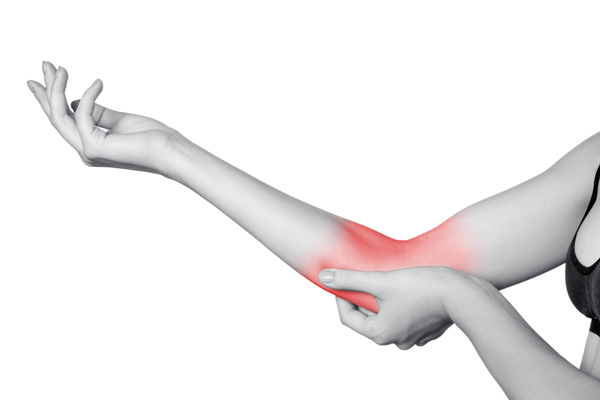Do I Have A Peripheral Nerve Entrapment Pain Syndrome?
Nerves perform many vital functions including sending signals from our body to our brain, helping us understand our environment and telling our bodies how to move and react. To accomplish this, complex systems of nerves extend out from the spinal cord and feed into the peripheral parts of the body. When these nerve systems or individual nerves are disrupted or compressed by surrounding structures, pain and discomfort can result. While some of the Peripheral Nerve Entrapment Pain Syndromes may be common, it doesn’t lessen the effect these syndromes have on daily life. Learn more about these conditions and the treatments available to those suffering.

What Are The Symptoms?
Nerve entrapment can happen in any location in the body. Nerve entrapment can affect the torso, limbs, or extremities, but usually impacts a localized site. Because of illness, injury, or repetitive motions, the nerves become compacted or compressed, causing symptoms to arise.
- Pain
- Numbness
- Tingling
- Muscle Weakness
- Redness, Swelling, and Inflammation
- Reduced Flexibility
Common Nerve Entrapment Syndromes
Some nerve entrapments happen at joints in the body such as the wrist, elbow, and base of the spine.
Carpal Tunnel Syndrome
The median nerve is compressed in the wrist, affecting the function and sensation of the thumb, middle and index fingers of the hand. Before permanent numbness or weakness set in the most common symptom is an annoying tingling sensation that frequently awakens the patient at night.
Cubital Tunnel Syndrome
The ulnar nerve is compressed at the elbow. The resulting pain feels similar to hitting your “funny bone” with pain and numbness radiating into the pinky and ring fingers.
Other types of nerve entrapments include:
Cluneal Nerve Entrapment Syndrome
This syndrome is often misdiagnosed as lumbar radiculopathy, sciatica, sacroiliac joint pain, gluteal bursitis or primary hip pain. The characteristic pain is localized to the iliac crest above the buttock and to the buttock itself and may be associated with tingling numbness or electric shock-like sensations in the same area.
Suprascapular Nerve Compression Syndrome
The pain is typically a severe, deep aching discomfort that originates at the top of the scapula and radiates into the shoulder. The entrapment is due to compression of the nerve at the suprascapular notch by a thickened ligament and may also be associated with weakness of the muscles of the shoulder.
Guyon’s Canal Syndrome
The ulnar nerve is compressed at the level of the wrist as it passes through a narrow tunnel resulting in localized pain and can lead to numbness extending into the pinky and ring fingers. The syndrome arises from repetitive trauma, fractures of a wrist bone, cysts, aneurysms or tumors.
Meralgia Paresthetica
Compression of the lateral cutaneous nerve of the thigh as it passes through or over the inguinal ligament results in pain and numbness in the same area as a front pant pocket.
Radial Nerve Compression Syndrome
Compression of the radial nerve can occur as a result of a fracture of the humerus or below the elbow where the nerve passes underneath a band of connective tissue. Pain and numbness are typically confined to the back of the forearm and hand, although weakness of the rist can occur in the absence of numbness.
What Are The Causes?
Since there are a wide variety of syndromes, the causes also vary. However, both repetitive motion, injury, and medical conditions can play a role in the development of Peripheral Nerve Entrapment Syndromes.
- Sports and repetitive motion injuries
- Fractures
- Arthritis and autoimmune disorders
- Diabetes
- Thyroid Dysfunction
- High Blood Pressure
How Do I Get Diagnosed?
Dr. de Lotbinière will review your medical history and perform a physical exam, discussing in-depth your symptoms and pain levels. Imaging or other diagnostic tools may be needed to confirm the diagnosis.
What Are My Treatment Options?
There are numerous types of Peripheral Nerve Entrapment Syndromes, and the approach for each one differs. Dr. Alain de Lotbinière is an expert in the diagnosis and treatment of neurological disorders and will make the right recommendation based upon your specific symptoms, treatment history, and medical conditions.
Common Treatments Include:
- Anti-Inflammatory Medication
- Physical Therapy
- Prosthetic or Corrective Devices
- Surgical Nerve Decompression
- Peripheral Nerve Stimulation
- Dorsal Ganglion Stimulation

The Path Forward
You don’t have to live with the pain of a Peripheral Nerve Entrapment Syndrome. Dr. Alain de Lotbinière can help. Book an appointment today at either his New York or Connecticut offices to get the answers you need to move forward toward the life you deserve. Dr. de Lotbinière currently accepts appointments in both White Plains, NY and Stamford, CT.
